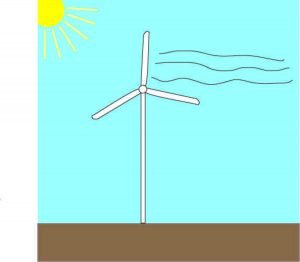Spain increasingly utilizing wind power
February 20, 2014
Last year, Spain’s number one energy source was wind turbines, providing 20.9 percent of its energy. This makes Spain the first country in the world to have wind power as its top energy source. It is possible that this is the start of future renewable energy sources becoming more popular amongst other countries.
Wind was not the only renewable source used by Spain. The country also has one of the world’s largest solar industries. Solar power provided 3.1 percent of Spain’s energy in 2013.

The sun causes movement of the wind, which many countries are now harvesting for electricity.
According to an article on geek.com, “There is still a reliance on coal and nuclear [power]; the results from 2013 show a 10.5 percent increase in renewable energy use over the previous year, which bodes well for the future if it continues.”
Wind power is becoming more and more widely used, although there are disadvantages to the source. The strength of wind constantly varies, changing the amount of power that is produced. Wind turbines which are used to produce the electricity can be noisy and quite the eyesore. There is also some pollution caused by this resource.
“The wind turbine production process can be a major source of air pollution without the proper controls in place. Manufacturing and painting the blades, towers and nacelles requires composite construction material and solvent based coatings,” according to anguil.com. “The potential to emit Volatile Organic Compounds (VOCs) and Hazardous Air Pollutants (HAPs) such as Xylene, Ethyl Benzene, Styrene and Phenol into the atmosphere is a major concern for communities and regulatory agencies.”
These disadvantages are outweighed by the advantages of wind power. Wind is renewable, free and it is able to be captured efficiently. It is also a resource that is everywhere, including third world countries. Power from wind help to generate electricity for countries that do not have access to other sources readily available.
“Many countries, especially in the developing parts of the world, have considerable wind resources that are still untapped. A key barrier in these countries is their lack of expertise, concerning both methods of site selection and technical aspects of wind power,” according to Dr. Jasper Abramowsk.
Many new technologies have been developed to advance the method of using wind for electricity. Sheerwind, for example, is a funnel shape, rather than spinning blades. The makers of Sheerwind have deemed it revolutionary.
“Bringing the airflow from the top of the tower to ground level allows for greater power generation with much smaller turbine blades. It also allows for networking, allowing multiple towers to direct energy to the same generator. The unit is about 50 percent shorter than traditional wind towers and uses a ground-based turbine with blades that are 84 percent smaller. Fewer generators are required, so equipment and maintenance costs are lower. Most importantly, energy output is greater,” according to sheerwind.com.
Spain could be setting an example for other countries to follow. Wind energy is inexpensive, efficient and environmentally safe. It could be the future of energy.






